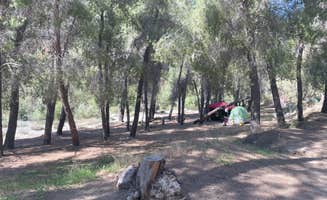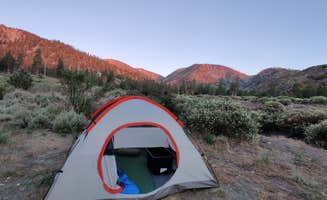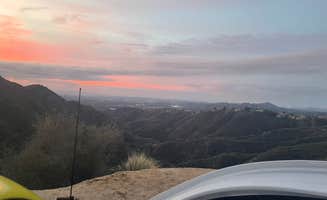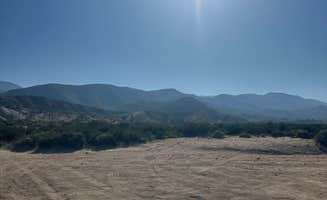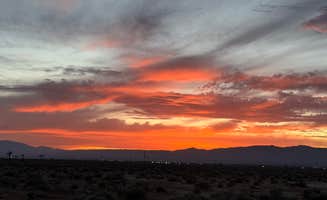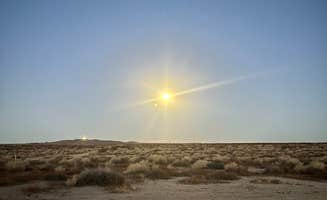Primitive camping near Pearblossom, California ranges across elevations from 2,800 to 5,000 feet, creating dramatic temperature variations throughout the seasons. The region sits at the intersection of desert and mountain ecosystems, with Joshua trees dominating lower elevations while pine forests appear at higher altitudes. Winter nights can drop below freezing while summer days often exceed 100°F, requiring campers to prepare for extreme conditions regardless of season.
What to do
Hiking accessible trails: From Bell Mountain Road, campers can access several unmaintained desert paths. "We didn't follow the directions all the way to the pin, there was plenty of parking on the way," notes one visitor who appreciated the open terrain for exploration.
Stargazing opportunities: The remote locations provide excellent night sky viewing with minimal light pollution. At East Mojave Camp, the isolation creates perfect stargazing conditions. One camper mentions, "Very remote absolutely nothing out there. Definitely somewhere you need to be aware of your surroundings."
Dog exercise areas: Some locations offer space for pets to run safely. At Hare School Park, one visitor explains, "There's a dog park kind of area with a big field they can run around and just clean up after them."
Photography at dawn: Desert sunrises provide spectacular photography opportunities. A visitor at BLM Desert Site reports, "I missed the sunset but caught a beautiful sunrise."
What campers like
Isolation from crowds: Many campers value the solitude of these primitive sites. At BLM Desert Site, a reviewer noted, "It's a great little secluded spot about 4 miles off the highway in the desert."
Night sky viewing: The dark skies away from urban light pollution create prime conditions for astronomy. "Staying here on memorial day and really nobody is here so that's nice," reports one camper about the peaceful conditions.
Vehicle accessibility: Some areas allow camping without difficult access roads. At Rim of the World Byway, a visitor mentions, "Easy in and out but next to train tracks. Quick stop friendly."
Joshua tree landscapes: The desert flora provides distinctive scenery not found elsewhere. "Several Joshua Trees," notes one visitor at Stoddard Wells Road area, highlighting the iconic desert plants that draw photographers and nature enthusiasts.
What you should know
Road condition challenges: Many access roads require appropriate vehicles. At Stockton Flats Yellow Post Sites, one camper warns, "The turn is not marked well, in fact the coordinates are a little bit off. If you miss the turn like we did you have to go 5 miles or more to get a turnabout big enough to turn around."
Safety considerations: Remote locations require self-sufficiency and awareness. "You need to be aware of your surroundings," cautions a visitor about the isolation at East Mojave Camp.
Navigation challenges: Many sites lack clear markers or addresses. "Use Google Maps; Waze takes you the wrong way," advises one camper about Rim of the World Byway, noting it's "just right off the freeway, not down a long, very bumpy dirt road."
Temporary closures: Forest Service lands occasionally close to dispersed camping. A visitor to Heaton Flats notes, "Camping outside established campgrounds within the Angeles National Forest is sometimes prohibited, you have to be on top of reading recently published orders."
Wind exposure: Desert sites often experience strong winds with no natural windbreaks. One camper at BLM Desert Site simply states, "Very windy," highlighting the need for secure tent stakes and sheltered cooking areas.
Tips for camping with families
Noise factors: Some areas experience traffic or party activity. At Angeles Crest Overlook to LA, a visitor observed, "Great view but on the weekend we had multiple cars doing donuts really close to our van. I felt uncomfortable with that."
Hidden trail options: Some sites offer unexpected recreation opportunities. "Next night we moved to the other look out and someone still did donuts behind us. There is a pull off before this that was very quiet near a trail and nobody bothered us," notes a camper who found a better spot with hiking access.
Weekday advantages: Many locations are quieter mid-week. "During the week it's more quiet," advises a visitor who found weekends busier at Angeles Crest areas.
Cell service reliability: Connectivity varies significantly by location. One camper at Angeles Crest notes, "Unfortunately I didn't have any service (Visible/Verizon), so that was a little scary," while others report adequate coverage at other sites.
Tips from RVers
Parking lot options: Some urban-adjacent areas allow overnight RV parking. At Hare School Park, a camper in a "25 foot Fleetwood RV" reports, "I've been here for a couple days and nobody's mess with us," though they caution it's "not tent friendly."
Clearance requirements: Many dispersed camping areas require high-clearance vehicles. "I put it in 4 wheel drive to pull my TAB trailer. Found a good spot. I can see other bigger rigs they did not require 4x4," explains a visitor to Rim of the World Byway.
Waste management: No services means planning for self-contained waste. "There's no public bathrooms, but there are trash cans so clean up after yourself please," advises an RVer at Hare School Park.
Road ruts and washouts: Desert roads can deteriorate quickly after rains. "Huge ruts in dirt road, there's room to go around them," notes a camper at East Mojave Camp, highlighting the need for careful driving even in accessible areas.


